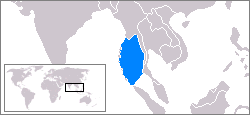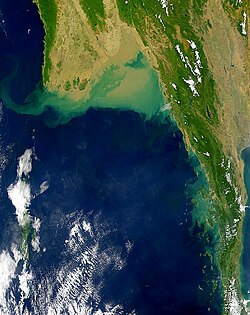The sea has long been used for fishing and transportation of goods between the coastal countries.
Fishing
Thailand alone harvested about 943,000 t (2.079×109 lb) of fish in 2005 and about 710,000 t (1.57×109 lb) in 2000. [20] Of those 710,000 t (1.57×109 lb),490,000 t (1.08×109 lb) are accounted for by trawling (1,017 vessels),184,000 t (406,000,000 lb) by purse seine (415 vessels),and about 30,000 t (66,000,000 lb) by gillnets. Of Thailand's total marine catch,41% is caught in the Gulf of Thailand and 19% in the Andaman Sea. 40% is caught in waters outside Thailand's EEZ. [21]
Production numbers are significantly smaller for Malaysia and are comparable,or higher,for Myanmar. [22] Competition for fish resulted in numerous conflicts between Myanmar and Thailand. In 1998 and 1999,they resulted in fatalities on both sides and nearly escalated into a military conflict. In both cases,the Thai navy intervened when Burmese vessels tried to intercept Thai fishing boats in the contested sea areas,and Thai fighter aircraft were thought to be deployed by the National Security Council. Thai fishing boats were also frequently confronted by the Malaysian navy to the extent that the Thai government had to caution its own fishers against fishing without license in foreign waters. [23]
The 2004 marine production in Thailand was composed of:pelagic fish 33 percent,demersal fish 18 percent,cephalopod 7.5 percent,crustaceans 4.5 percent,trash fish 30 percent and others 7 percent. [12] : 12 Trash fish refers to non-edible species,edible species of low commercial value and juveniles,which are released to the sea. [12] : 16 Pelagic fishes were distributed between anchovies (Stolephorus spp.,19 percent),Indo-Pacific mackerel ( Rastrelliger brachysoma,18 percent),sardinellas (Sardinellars spp.,14 percent),scad (11 percent),longtail tuna ( Thunnus tonggol ,9 percent),eastern little tuna (Euthynnus affinis,6 percent),trevallies (6 percent),bigeye scad (5 percent),Indian mackerel (Rastrelliger kanagurta,4 percent),king mackerel (Scomberomorus cavalla,3 percent),torpedo scad (Megalaspis cordyla,2 percent),wolf herrings (1 percent),and others (2 percent). [12] : 13 Demersal fish production was dominated by purple-spotted bigeye (Priacanthus tayenus),threadfin bream (Nemipterus hexodon),brushtooth lizardfish (Saurida undosquamis),slender lizardfish (Saurida elongata) and Jinga shrimp (Metapenaeus affinis). Most species are overfished since the 1970s–1990s,except for Spanish mackerel (Scomberomorus commersoni),carangidae and torpedo scad (Meggalaspis spp.). The overall overfishing rate was 333 percent for pelagic and 245 percent for demersal species in 1991. [12] : 14 Cephalopods are divided into squid,cuttlefish and molluscs,where squid and cuttlefish in Thai waters consists of 10 families,17 genera and over 30 species. The main mollusk species captured in the Andaman Sea are scallop,blood cockle (Anadara granosa) and short-necked clam. Their collection requires bottom dredge gears,which damage the sea floor and the gears themselves and are becoming unpopular. So,the mollusk production has decreased from 27,374 t (60,349,000 lb) in 1999 to 318 tonnes in 2004. While crustaceans composed only 4.5 percent of the total marine products in 2004 by volume,they accounted for 21 percent of the total value. They were dominated by banana prawn,tiger prawn,king prawn,school prawn,bay lobster ( Thenus orientalis ),mantis shrimp,swimming crabs and mud crabs. The total catch in 2004 was 51,607 t (113,774,000 lb) for squid and cuttlefish and 36,071 tonnes (79,523,000 lb) for crustaceans. [12] : 18–19


















